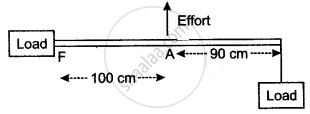Advertisements
Advertisements
Question
A crowbar of length 100 cm is used to lift a load of 5 kgf. It has its fulcrum at a distance of 20 cm from the load. Calculate:
(i) the mechanical advantage of a crowbar and,
(ii) the effort applied at the other end.
Solution
Given: L = 5 kgf, Load arm = 20 cm, Effort arm = 100 – 20 = 80 cm.
(Since the crowbar is the lever of first order with the fulcrum in between the load and the effort).
(i) Mechanical advantage =`("Effort arm")/("Load arm")=80/20=4`
(ii) M.A. =`"Load(L)"/"Effort(E)"`
∴ Effort =`"Load(L)"/"M.A."=5/4`
= 1.25 kgf.
APPEARS IN
RELATED QUESTIONS
What is a lever?
shows a nut cracker name the class of lever ?
Give three examples for leavers of the third order.
The following belong to which class of lever?
The Physical balance
The following belong to which class of lever?
A claw-hammer
The following belong to which class of lever?
Nutcracker
Shears, used for cutting metals and scissors used for cutting clothes are both examples of levers of the first order. However, whereas the shears always have short blades and long handles, the scissors often have blades much longer than the handles. Explain, why this is so?
What is a lever?
The diagram shows the use of a lever.

- State the principle of moments as applied to the above lever.
- Which class of lever is this? Give an example of this class of lever.
- If FA = 100 cm, AB = 90 cm, calculate the minimum effort required to lift the load.
The length of a nut-cracker is 12 cm. A nut, when kept at a distance of 4 cm from its fulcrum, requires an effort of 100 gf to crack it. What force will be required to crack the nut without using the nut-cracker?
